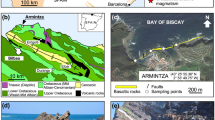Abstract
Towada caldera, lying near the northern end of Honsyu, Japan was constructed by eruptions of lavas and pyroclastic materials in three separate periods. At the ends of the first and second periods, great amounts of pumice were erupted in the form of pumice flow and fall respectively. Each pumice cruption was followed by collapse of the center of the cones resulting in double calderas. The lavas of these three periods and the pumice of the first and second periods were chemically analysed. The result was plotted in several different types of variation diagrams. The points for the lavas and pumice lie generally on smooth curves, indicating that the magmas which caused the pumice cruptions belong to the same general differentiation series as do the lavas. If SiO2/FeO+Fe2O, is plotted against sodification index (MgO x 100/MgO+FeO+Fe2O, +Na2O+K2O), points for the lavas lie on a straight line, whereas those for the pumice lie on another straight line branching from the former at some point in the middle stage of differentiation. The rate of increase of this ratio in the pumice is greater than in the lavas, implying that less SiO2 and more iron were subtracted from the magmas producing the pumice than from those producing the lavas. This was probably caused by crystallization of a greater amount of magnetite in the former magmas possibly due to higher oxygen partial pressure which may be in turn related to higher water content. It is not necessary to postulate melting of the crust in order to generate magmas of the pumice eruptions of the central type.
Similar content being viewed by others
References
Ishikawa, T., Minato, M., Kuno, H., Matsumoto, T., andYagi, K., 1957 —Welded tuffs and deposits of pumice flows and miées ardentes in Japan. XXth Intern. Geol. Congr., Mexico, 137–150.
Kawano, Y., 1939 —Chemical study of erupted materials of Towada Volcano. Jour. Jap. Ass. Min. Petro. Econ. Geol.,22, 223–239 (in Japanese).
Kuno, H., Yamasaki, K., Iida, C., andNagashima, K., 1957 —Differentiation of Hawaiian magmas. Jap. Jour. Geol. Geogr.,28, 179–218.
Kuno, H., Ishikawa, T., Katsui, Y., Yagi, K., Yamasaki, M., andTaneda, S., 1964 —Sorting of pumice and lithic fragments as a key to eruptive and emplacement mechanism. Jap. J. Geol. Geogr.35, Nos 2–4, 223–238.
Osborn, E. F., 1959 —Role of oxygen pressure in the crystallization and differentiation of basaltic magma. Amer. J. Sci.,257, 609–47.
Soma, T., 1951 —Geology of Towada and Kosaka district, Akita and Aomori Prefectures. Graduation thesis for the University of Tokyo (MS).
Tomitn, T., 1930 —Geological study of Lake Towada. Rep. Study of Natural Monuments, Ministry of Education, Section Geology and Mineralogy,4, 1–25 (in Japanese).
Yagi, K., Matsuyama, T., andNanasaki, O., 1960 —Density of pumice with reference to the mechanism of formation of welded tuffs. Volc. Soc. Japan, Bull. Ser. 2.5, 99–109 (in Japanese).
Author information
Authors and Affiliations
Additional information
Paper read at the IAV International Symposium on Volcanology (New Zealand), scientific session of Nov. 29, 1965.
Rights and permissions
About this article
Cite this article
Chiba, M. Genesis of magmas producing pumice flow and fall deposits of towada caldera, Japan. Bull Volcanol 29, 545–558 (1966). https://doi.org/10.1007/BF02597175
Issue Date:
DOI: https://doi.org/10.1007/BF02597175




